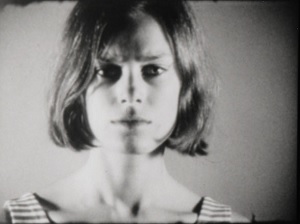
Portraiture: The creation of any portrait; an artistic representation of a person, including portrait painting, portrait photography, or self-portrait. (by Ben Sachs) As part of the multimedia exhibition “Persistence of Motion,” which took place at the Nightingale in Chicago recently, video artist and ImprovOlympic performer Jared Larson spent about 15 minutes in front of the room, shooting the audience with a camera and projecting his results onto the screen behind him.
Larson zoomed in on each spectator and held the shot for several seconds, making everyone the subject of an impromptu screen test. “Most people stare at the screen instead of the lens,” he said at one point, speculating we’d all grown accustomed to looking for our faces on surveillance-camera monitors.
I hadn’t gotten my turn to be onscreen when he said this, so when Larson did point the camera at me, I made sure to return its gaze. This way, other people could study my portrait (for whatever that might be worth) without having to deal with my self-regard. Larson’s comment—not to mention memories of Andy Warhol’s screen tests—made me think a dead-ahead stare would be a more compelling image.
I can’t say for certain how my close-up turned out (like I said, I wasn’t looking), but I still appreciated being part of Larson’s exercise. Like the Harun Farocki short Counter-Music (2002), which screened at the Nightingale in January, the performance made me ponder how many images I regularly encounter that I don’t even think of as images.
I didn’t need Larson’s comment to remind me of surveillance footage—that was the first thing I thought of when I saw my fellow spectators onscreen. Yet how often does one see the face of another on a security feed and think of portraiture?
Also, does the ubiquity of security feeds—as well as countless other moving images that are captured without creative intent—inhibit our ability to appreciate genuine portraiture when we see it?
(Image: Lucinda Childs in one of Andy Warhol’s screen tests)
Source: chicagoreader.com
